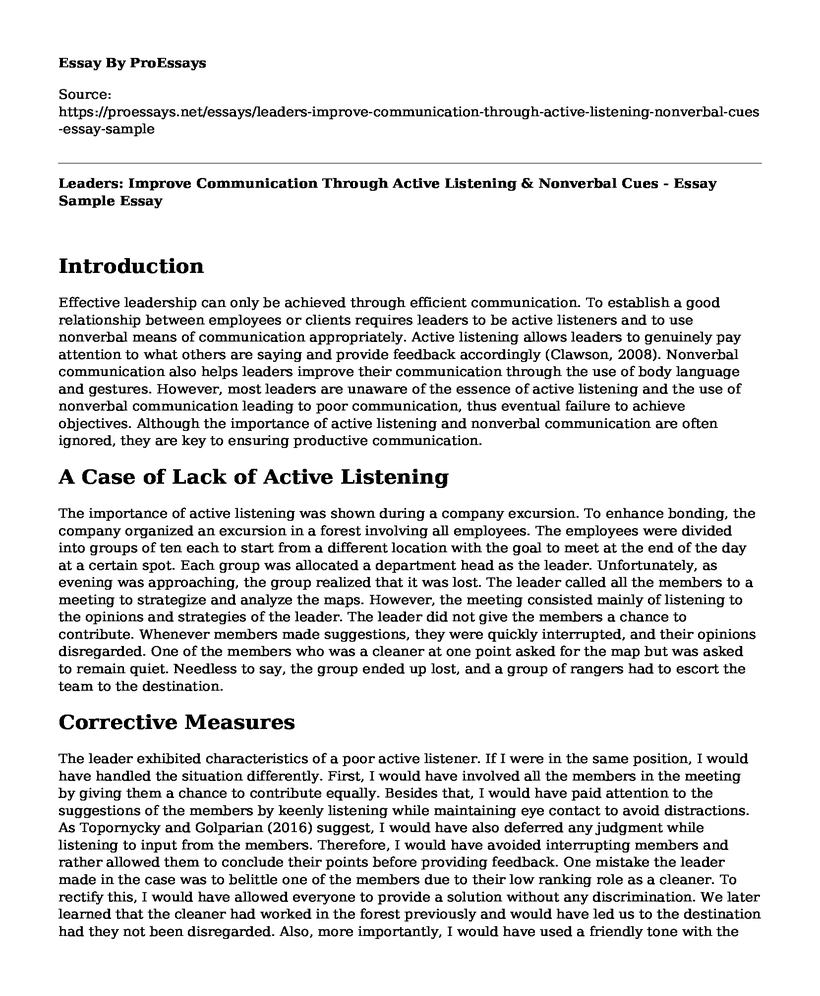Introduction
Effective leadership can only be achieved through efficient communication. To establish a good relationship between employees or clients requires leaders to be active listeners and to use nonverbal means of communication appropriately. Active listening allows leaders to genuinely pay attention to what others are saying and provide feedback accordingly (Clawson, 2008). Nonverbal communication also helps leaders improve their communication through the use of body language and gestures. However, most leaders are unaware of the essence of active listening and the use of nonverbal communication leading to poor communication, thus eventual failure to achieve objectives. Although the importance of active listening and nonverbal communication are often ignored, they are key to ensuring productive communication.
A Case of Lack of Active Listening
The importance of active listening was shown during a company excursion. To enhance bonding, the company organized an excursion in a forest involving all employees. The employees were divided into groups of ten each to start from a different location with the goal to meet at the end of the day at a certain spot. Each group was allocated a department head as the leader. Unfortunately, as evening was approaching, the group realized that it was lost. The leader called all the members to a meeting to strategize and analyze the maps. However, the meeting consisted mainly of listening to the opinions and strategies of the leader. The leader did not give the members a chance to contribute. Whenever members made suggestions, they were quickly interrupted, and their opinions disregarded. One of the members who was a cleaner at one point asked for the map but was asked to remain quiet. Needless to say, the group ended up lost, and a group of rangers had to escort the team to the destination.
Corrective Measures
The leader exhibited characteristics of a poor active listener. If I were in the same position, I would have handled the situation differently. First, I would have involved all the members in the meeting by giving them a chance to contribute equally. Besides that, I would have paid attention to the suggestions of the members by keenly listening while maintaining eye contact to avoid distractions. As Topornycky and Golparian (2016) suggest, I would have also deferred any judgment while listening to input from the members. Therefore, I would have avoided interrupting members and rather allowed them to conclude their points before providing feedback. One mistake the leader made in the case was to belittle one of the members due to their low ranking role as a cleaner. To rectify this, I would have allowed everyone to provide a solution without any discrimination. We later learned that the cleaner had worked in the forest previously and would have led us to the destination had they not been disregarded. Also, more importantly, I would have used a friendly tone with the group to ensure calmness and avoid spreading panic.
Conclusion
The use of nonverbal means of communication and active listening are key aspects in ensuring effective communication, especially for leaders and managers. Success in active listening lies in focusing on the speaker without interrupting them while making use of gestures and body language to show the eagerness to listen. Active listening thus allows leaders to understand other members and provide appropriate feedback to avoid arguments and ensure the objectives are met.
References
Clawson, J. (2008). Active Listening. University of Virginia. Retrieved from https://www.researchgate.net/publication/228144342_Active_Listening
Topornycky, J., & Golparian, S. (2016). Balancing Openness and Interpretation in Active Listening. Collected Essays on Learning and Teaching, IX. Retrieved from https://files.eric.ed.gov/fulltext/EJ1104498.pdf
Cite this page
Leaders: Improve Communication Through Active Listening & Nonverbal Cues - Essay Sample. (2023, Mar 27). Retrieved from https://proessays.net/essays/leaders-improve-communication-through-active-listening-nonverbal-cues-essay-sample
If you are the original author of this essay and no longer wish to have it published on the ProEssays website, please click below to request its removal:
- Ethics Program of Company X
- Understanding "Comfort" and "Discomfort" in an Interview Essay
- Essay Sample on Personal Leadership Reflection Template
- Project Planning: Time, Quality & Resources - Research Paper
- Paper Example on Enhancing Interpersonal and Communication Skills: My Work History
- Decision-Making: Types of Errors & Roles of Managers - Free Paper Sample
- Project Management - Essay Sample







